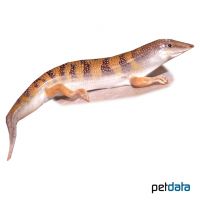Sandfish Skink (Scincus scincus)
| Sandfish Skink Scincus scincus | |
|---|---|
| Name | Sandfish Skink |
| Name Lat. | Scincus scincus |
| Family | Skinks |
| Family lat. | Scincidae |
| Order | Scaled Reptiles |
| Order lat. | Squamata |
| Origin | Africa, Asia |
| Habitat | Dry savanna, desert |
| Diet | Insects |
| Humidity | 50-60 % |
| Behavior | Peaceful |
| Keeping | Individual, pair |
| Care Level | Easy |
| Reproduction | Oviparous |
| Housing | Dry terrarium |
| Life Span | 10 years |
| Protection | No |
| Metric Units | |
| Size | 20 cm |
| Temperature | 23-28 °C |
| Temperature Local | 45 °C |
| Housing Size | 80 x 50 x 50 cm |
| US Units | |
| Size | 7.9" |
| Temperature | 73-82 °F |
| Temperature Local | 113 °F |
| Housing Size | 30" x 20" x 20" |
Distribution and habitat
Diurnal to crepuscular, apothecary skinks are widespread from northwest Africa through the Arabian Peninsula to Iran. They live in deserts and semi-deserts as well as in dry savannahs and cultivated landscapes on sand, in which they often bury themselves.
Maintenance
Minimum dimensions for the terrarium, according to the size and number of animals
| 1-2 animals | 5KRL x 4KRL x 3KRL (L x W x H) |
Head-torso length (KRL) is measured on the largest animal. For each additional animal, increase the footprint by 15%. A terrarium of L 80 x W 50 x H 50 cm for 1-2 animals is recommended, which should be placed in a quiet and vibration-free place
They need a dry terrarium with flat stone structures, hiding places and structured back and side walls (e.g. cork covering) as well as a small water bowl and a 20 cm deep substrate for digging. Fine sand or bird grit covered with some dry leaves, pieces of bark and debris is suitable for this, as well as planting for decoration (succulents, ornamental grasses, cacti, etc.). In the morning and evening the terrarium should be finely sprayed with water inside (humidity), but it is better to use a rain or fog system.
| Temp. day: 23-28 °C | Temp. night: 17-20 °C | Temp. local: up to 45 °C | Humidity: 50-60 |
The lighting duration must be 12-14 hrs. depending on the season. They need high light intensity and daily UV irradiation as well as sunny places with radiant heat.
Diet
The food supply consists of live insects, such as crickets, house crickets, grasshoppers, beetles, spiders, zophobas, etc. Alternatively, special ready-made food for insectivorous reptiles can be offered, possibly with tweezers for habituation. Wax moths should rarely be fed in very small amounts due to their large fat content. Regular addition of minerals and vitamins (e.g. by dusting the feeders) is important. Young animals should be offered food daily, adults 4-5 times a week. Drinking water must always be available
A regular and varied diet promotes health and prevents deficiency symptoms.
Reproduction and breeding
The sexes are difficult to distinguish. The males are slightly larger. A reliable sex determination is only possible by testosterone determination or endoscopy.
They are oviparous and a clutch consists of 3-8 eggs. The incubation period is 55-60 days at a temperature of 26-28 °C. However, viviparous females have also been observed. Small insects such as fruit flies, aphids, micro crickets, etc. are suitable as initial food
The life expectancy can be 10 years.
Important
They can be kept in a group and behave territorially only during the mating season. They are often aggressive towards other species
With their very smooth scales, a wedge-shaped snout for burrowing and ear openings covered with scales, they are fully adapted to life in the sand. They bury themselves in the sand when it is hot and dangerous, but they also lie in wait for their prey in this way when hunting.
According to their need for light and warmth, they require sunny places, such as spots irradiated by a spotlight. A hibernation of about 2 months, at a temperature of 15-18 °C and a lighting period of about 8 hours is recommended. The quality of the food animals can be upgraded by giving fruit and honey water as food.
The terrarium must have good ventilation without drafts and meet the species specific needs. Measuring devices such as thermometers, hygrometers, etc. are necessary. The lighting has to correspond to the species-specific day-night rhythm and has to be placed in such a way that the animals cannot injure themselves. The terrarium should be locked in such a way that neither unauthorized persons can open it nor the animals can escape. Contamination must be removed regularly
Further literature can be found in your pet store.
References
Text: petdata; Image: petdata
Source: BMELV (1997): Tierschutzgutachten - Mindestanforderungen an die Haltung von Reptilien; ENGELMANN (2006): Zootierhaltung - Tiere in menschlicher Obhut: Reptilien und Amphibien, Harri Deutsch Verlag
- Gemäß § 21 Abs. 5 Tierschutzgesetz idgF
